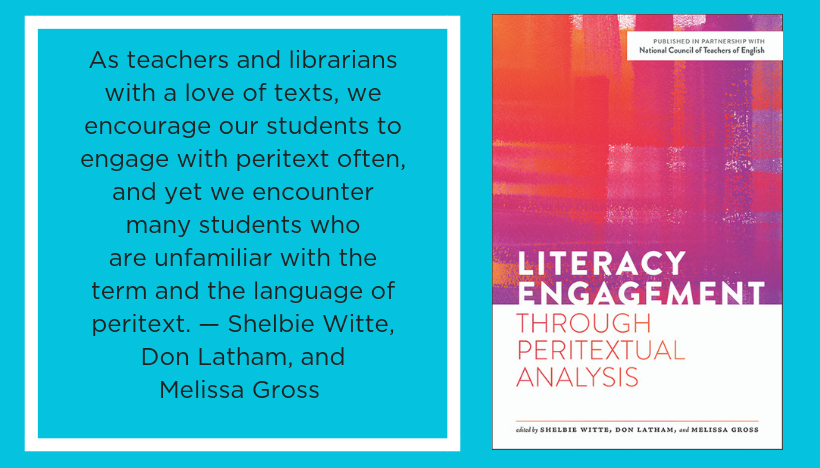This post was written by Shelbie Witte, Don Latham, and Melissa Gross, editors of Literacy Engagement through Peritextual Analysis (ALA & NCTE, 2019).
As teachers and librarians with a love of texts, we encourage our students to engage with peritext often, and yet we encounter many students who are unfamiliar with the term and the language of peritext. Common peritextual elements such as the text cover, table of contents, and source notes provide opportunities for readers to increase their comprehension of and to think critically about a text. Many times, readers will skip the reading and viewing of peritext and begin with the text proper. By doing so, they are often missing critical information an author has included about the text and haven’t taken advantage of all the layers of meaning surrounding the text.
The Peritextual Literacy Framework (PLF), developed by Gross and Latham (2017), promotes a skill “that has significance for a variety of other literacies, such as information literacy, media literacy, digital literacy, visual literacy, cyber literacy, and information fluency” (Gross, 2019, p. 5). The PLF, used with both print and nonprint media, allows opportunities for readers to navigate complex texts by element and function. Production, Promotional, Navigational, Intratextual, Supplemental, and Documentary elements work independently and in conjunction with one another to connect the reader to the added dimensions of the text proper.
For example, Crag Hill used the PLF as a prereading exercise to examine the book covers, spines, and inside cover flaps of Gene Luen Yang’s two-volume graphic novel Boxers & Saints (Hill, 2019, pg. 35). By predicting the plot and themes of the texts in advance of the reading, students had visual clues to return to throughout their close reading of the texts, enhancing their comprehension of the text proper.
Librarians Rebecca Weber and Kevin Dyke examined the mining of the author’s note, a Documentary element, while exploring the young adult historical fiction novel Dreamland Burning. In historical fiction, “the author’s note serves as a bridge between fact and fiction, highlighting research the author did to ensure historical accuracy and emphasizing issues the author deems important” (Weber & Dyke, 2019, p. 88–89).
And in one of several examples of the integration of the PLF with media and non-print texts, Peter Kunze examines the functions of Disney DVD covers as production and promotional elements to “encourage readers and viewers to understand themselves interchangeably as critics, evaluators, consumers, and meaning makers” (Kunze, 2019, p. 147). Guiding students to turn a critical eye to the acclaim and reception of texts versus text quality and notions of “success” allows for a deeper understanding of the power of media.
Ultimately, the peritext enhances a reader’s connection with a text through a close reading of elements that are often ignored. The Peritextual Literacy Framework can serve teachers and librarians with a guided approach to literacy engagement.
Works Cited
Gross, M., & Latham, D. (2017). The Peritextual Literacy Framework: Using the functions of peritext to support critical thinking. Library and Information Science Research, 39(2), 116–123.
Hill, C. (2019). Peritextual bridges: Predicting plot and theme in Boxers & Saints. In S. Witte, D. Latham, & M. Gross (Eds.), Literacy Engagement through Peritextual Analysis. Chicago, IL: American Library Association and the National Council of Teachers of English.
Kunze, P. (2019). (Re)covering Disney: Media peritexts and media literacy in the classroom. In S. Witte, D. Latham, & M. Gross (Eds). Literacy Engagement Through Peritextual Analysis. Chicago, IL: American Library Association and the National Council of Teachers of English.
Weber, R., & Dyke, K. (2019). A sense of time and place: Using the author’s note in a historical fiction novel to introduce primary sources and teach critical thinking. In S. Witte, D. Latham, & M. Gross (Eds.) Literacy Engagement through Peritextual Analysis. Chicago, IL: American Library Association and the National Council of Teachers of English.
Shelbie WItte, Don Latham, and Melissa Gross are editors of Literacy Engagement through Peritextual Analysis, copublished by the American Library Association and the National Council of Teachers of English in 2019. Written for K–16 teachers and librarians, the collection explores the origin of peritextual analysis and the uses of it with print and nonprint texts to support visual literacy and critical thinking explorations with a wide range of learners.

Shelbie WItte is the Chuck and Kim Watson Endowed Chair in Education and professor in adolescent literacy and English education at Oklahoma State University, where she directs the OSU Writing Project and leads the Initiative for 21st Century Literacies Research. She serves as coeditor (with Sara Kajder) of NCTE’s Voices from the Middle.

Don Latham is a professor in the School of Information at Florida State University. His research focuses on digital literacies, information behavior of young adults, graphic novels, and nonfiction resources for young adults.
 Melissa Gross is a professor in the School of Information at Florida State University, where she teaches and does research in the areas of information-seeking behavior, resources for youth, research methods, information literacy, and teacher and librarian collaboration.
Melissa Gross is a professor in the School of Information at Florida State University, where she teaches and does research in the areas of information-seeking behavior, resources for youth, research methods, information literacy, and teacher and librarian collaboration.

